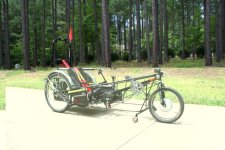John in CR said:
swbluto,
I've all but decided to go with a construction method I used to build a sailboat. I used it to build a beach catamaran that's right at 5 meters long with an all up weight of under 80kg, and that's using some extra glass+epoxy layers in addition to what was called for by the designer. We're talking two 5m hulls and rigging for a strong seaworthy craft, so it approaches the lightest weight composite structures with very little build effort. Support framework would go away other than attachment areas to the bike, and the real beauty is the exterior turns out paint ready verses the weeks/months of work to prep those HPV velo's of composite construction.
The base construction material is very thin plywood, and my only concern is just how far I can bend it for the curves I need. I'll do some tests over the next week or two, and share the construction process in pics and clips section. I have no doubt that this method can produce a stronger, more rigid, and lighter shell than the corrugated plastic, without too much extra work, and almost no tools.
John
Cool! If the wood could be treated so that it'd be flame-retardant, that'd be a pretty sweet alternative.
Anyways, I was wondering about the "roll cage". I saw some normal car roll-cage listed weights and they were like 100-200 lbs for mild steel. Apparently cro-moly can be made a bit lighter, but it's tougher to get a reliable weld and so it isn't trusted as much as mild steel (And I certainly wouldn't trust with myself that much with welding). An alternative seemed to be some kind of T4x steel where I think x is 1 that seemed to be 20% lighter than mild steel and doesn't have as much issues with welding reliability.
I decided to get some info from wikipedia at http://en.wikipedia.org/wiki/Drag_coefficient, and here's the very informative graphic listed there.

It seems an angled side has about twice as large a drag coefficient as something spheroidal in shape, so it seems curved sides would be far better when dealing with cross-winds (half the force, assuming the same cross-sectional area). I kind of wonder what ellipses would have for a drag coefficient, or maybe a tapered ellipse.
According to http://www.unicopter.com/1021.html, an ellipse could get down to a drag-coefficient of .25 depending on the ratio of the length to height, so it looks like it could possibly be reduced to a drag coefficient from .47 of a sphere to .35 of a semi-ellipse in practice. However, that'll affect the frontal area as well, so that looks like it'd take some optimization. Eh, I'd just copy parts of aptera's basic design as I'm sure they took that into account.
Also, to revisit the viability of a trike in snowy climates, it does seem like it wouldn't be that good for snowy weather due to the increased drag from the three straight tracks. It seems the middle wheel would be particularly horrendous as that's not where the car's markings are, so I thought... let's extend the back two wheels to a normal car's wheelbase, and then let's make the front wheel interchangeable with a ski with the flick of a button.

Ok, so I'm dreaming, but it would sound like one way to go about it. I don't know how steering would be implemented, though...
So, in essence, I'm abandoning that idea.
Also, I kind of wondered - why wouldn't this thing be taken on bike paths? Well, one reason is that it doesn't look like a bike and that's be good enough to get arrested in many districts. But assuming people judge on more than appearances (haha, a joke, I know.), should normal pedal velomobiles also be banned? What about recumbents? What about recumbents with half-fairings? What about recumbents with full fairings? Is is the mere full-fairing that makes it illegal?
Well, assuming that velomobiles would be allowed (assuming they went the proper speed and gave courtesy to other users), a major obstacle would be the non-standard wheel-base that I'd want. And quite properly, I don't think wide wheel-based vehicles should be allowed on standard bike paths (And I definitely don't think gas vehicles should be allowed on paths - it sickened me to see motorcycles riding down a bike path). So what if the back wheel base was retractable as needed, and the wheel base could conform to that of a normal pedaled velomobile? I still don't think it'd go without law enforcement hassles in real life, but it's nice to think that it could theoretically be allowable. Anyways, retractable wheel-bases, FTW! I've never seen that, so it's probably just another dream.




